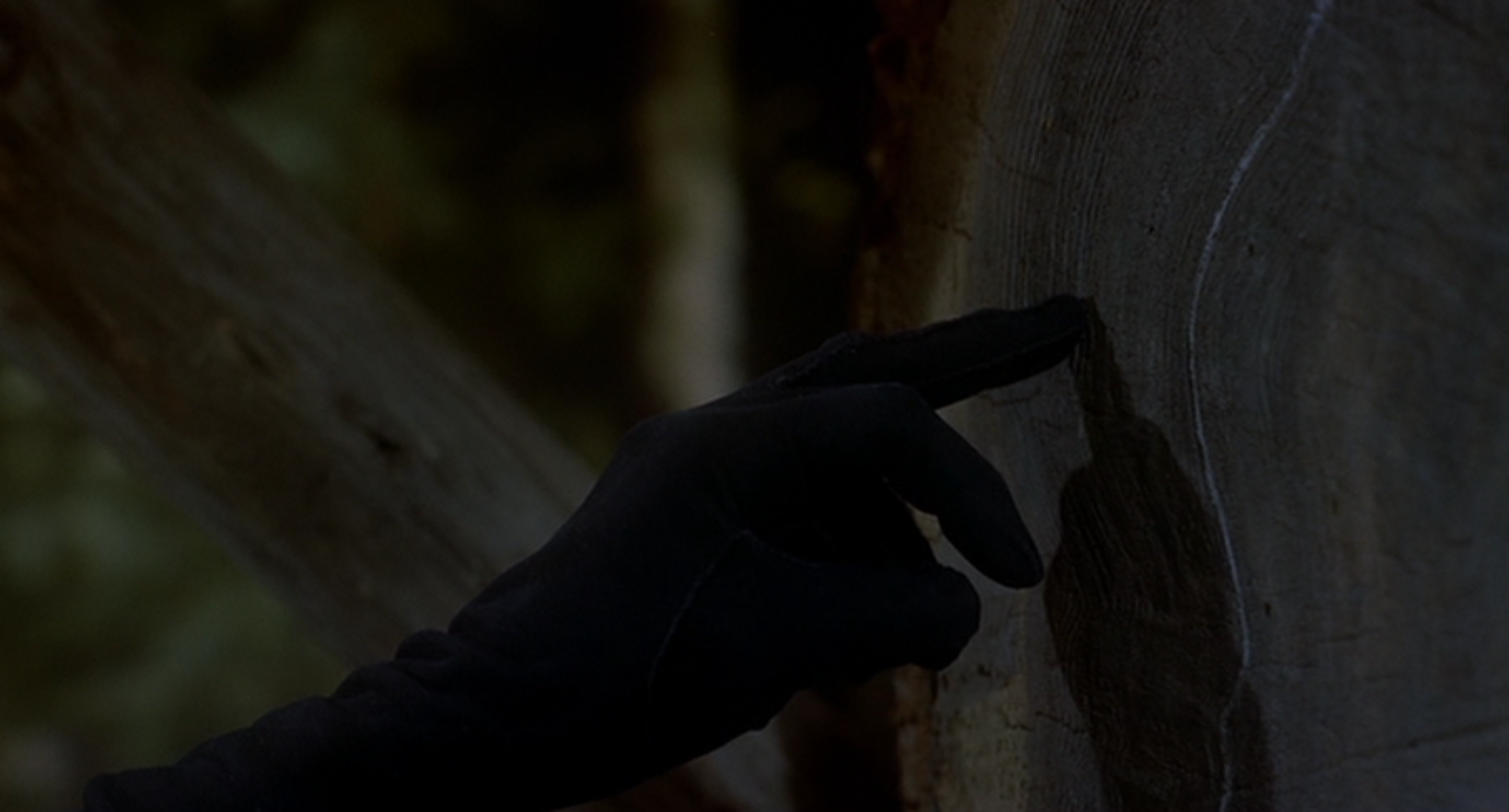
Vertigo TOC | Part 1 | Part 2 | Part 3 | Part 4 | Part 5 | Films Home
LINKS TO SECTIONS OF THE ANALYSIS ON THIS PAGE:
John's Apartment
The Letter
Lombard Street and the Tabula Scalata
Always Green, Ever Living
I've gone back to my first love
You've been there before
San Juan Bautista
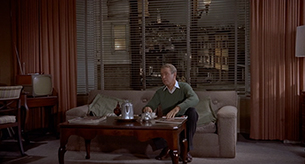 |
 |
We have been to Midge's apartment twice. We have twice seen the exterior of where Madeleine lives. This is our first visit to John's and perhaps it is a bit of a surprise, that John would live in a modern building and have a bright red front door, and plate-glass windows rather than small window panes, the antique street lamp hanging on the pole just outside standing in sharp contrast. Madeleine's car sits in a parking space out front, but not John's car. He will have to take a taxi back to Fort Point to retrieve his car. Using Madeleine's car he's given an opportunity to drive a magnificent Jaguar, plus when she leaves she'll be able to use her own car and not, he believes, become familiar with his own car which would result in his being unable to use it for following her thereafter, not that Elster wouldn't be able to foot the expense of renting another car.
Note that John lives on the first floor where he won't be ever reminded of his fear of heights and vertigo.
Crossfade to John, in his living room, tossing a couple of logs on a fire. It's 1958. The furnishings in this living room and in his bedroom are going to likely resonate familiarly with a certain very solid middle class across America. Is the interior of his apartment intended to represent a typical middle class bachelor's lifestyle? I don't know. But it is very comfortably and respectably middle class, with the furnishings and decorations and carpet and wallpaper of my paternal grandparents practically duplicated down to the glassware and touches of Oriental pottery. It was unisex design. Everything in John's place is going to be well tended. Solid. Any extravagances will be to assure there is a place for everything and everything is in its place, in proper order, in the dedication to keeping wear and tear at bay, in investing in good materials as they will wear well. Beyond that red door, nothing much will stand out, except for a few small touches, thus all the variations on brown (with a touch of mauve), the light rust brown drapes adding warmth and the walls that are papered with a tan fabric wallpaper ably complementing the drapes and the carpet and all the matching wood but also supplying its own bit of character with its contribution of modern texture. Everything is both modern and classic. There is no hint of Midges's bohemianism. One can't just pick up any piece of furniture one likes at the flea market and toss it in here, one has to consider whether the new thing will match. There is no clutter. The few books and periodicals stacked against the wall will be too organized to be defined as clutter. John's sinks will be spotless. His drains will drain well. His oven will be free of grease. He may have someone in to clean or twice a month.
John's clothing matches his furnishings. The dulled green of his sweater doesn't clash with the green of his throw cushions.
Curiously, if he has ever appreciated Midge's art, there is none on display. Despite her attachment to John, it would be difficult to imagine Midge being comfortable here. But when we see Madeleine, she will somehow manage to fit right in, perhaps because she's in John's robe.
The camera pans around to reveal the anomalous—in John's kitchen hang Madeleine's clothing drying out—her dress, her long white scarf, a petticoat, stockings, underwear, gloves, but no bra, which seems a nod to John's amazement at the ambitious new brassiere with its cantilever design that Midge was illustrating. The camera continues its pan to show the green ice container on John's dining table that is used instead as a bar (throughout the film, Hitchcock tosses in here and there green appointments), and settles on John's bedroom, where we see Madeleine sleeping in his bed. We understand immediately that, caring for the woman, he has stripped her completely of her wet clothing before putting her to bed. Which is sensible. But at the same time we will be made uncomfortable because there's also something not quite right about it. Yet we may also feel for John, aided by the music, that the woman's clothes drying in his apartment's kitchen perhaps make his apartment feel whole to him in a way that it hasn't before. He is caretaking. But he is tending a fantasy.
Cut back to John on his sofa, drinking a cup of coffee, his eye on Madeleine from this distance. We see his reading material—newspapers, news magazines, and issues of Swank. Swank, circa the 1950s, was akin to Esquire, featuring adventure and sci fi by authors such as Norman Mailer, Graham Green, Arthur, C. Clarke, humor, and pin-ups. The covers are fairly cringe-pulp. A 1957 issue promised "Those Slippery Convention Girls", "A New One About the Farmer's Daughter", and the "Diary of a What-the-Hell Girl", while also offering a new dramatic story by William Saroyan. Another issue teased with "Those Witchy Girls of Greenwich Village" while advertising a new story by Graham Greene. A bright red November 1957 issue showed a model draped with a towel under the headline, "Play With Me Before I Die". It had an article on Alfred Hitchcock, and the story, "Confessions of a Not-so-innocent Abroad". Common to the Swank magazines of that era was the cartoon mascot of the gentlemanly (well-dressed and groomed, portly, white hair, pert mustache) dirty old man always tucked into a situation with one or several young women. That is the bachelor pad item in John's apartment, the fact he has left it casually out on his coffee table.
John hears Madeleine speak in her sleep and rises from the sofa. Then the phone rings in his bedroom, on the table beside his bed, the one Madeleine is resting in, and he rushes to pick it up. As he answers, Madeleine turns over, nude under his yellow blanket and white sheet. We understand it's likely Gavin who has called, the way John says it's all right and that he'll call back. Madeleine realizing that she is nude, John asks her if she's all right, and though he seems to do so tenderly, as he hands her his robe and tells her she will be needing it, then exits, I'm not certain it isn't without a hint of swagger and a certain amount of power over her accrued by his having seen and handled her nude body, though we also understand John wouldn't have done anything sexual with her.
Exiting and closing the door so Madeleine may put on the robe, John goes to the kitchen to get a coffee cup for her and carries it to the coffee table. The music again signals we are to be feeling a certain sweet poignance, and then as Madeleine opens the door, dressed in John's red robe, her hair mussed, barefoot, John smiles and nods her over to the fire where it's warm. He explains she fell into San Francisco Bay and then rather aggressively insists again that she come over by the fire, placing cushions on the floor for her. When he queries what she remembers, he realizes she doesn't recollect where she was before going to the Presidio, and doesn't remember how she fell into the water. When she asks what he was doing before going to the Point, he tells her frankly that he was at the Palace of the Legion of Honor. What if she had remembered this? What would he do? But she doesn't remember and even says she has never been inside. She says that he shouldn't have brought her there, and he tells her that he didn't think she'd want to go home like "that". Which is to presume a lot about a woman he supposedly knows nothing about. She has said she must have had a dizzy spell and fainted, and he doesn't argue this, so the first time watcher of the film will assume that Madeleine doesn't know that she attempted suicide, but that perhaps she knows she has "episodes" and is bothered enough by them that she would go along with what John has said, not wanting to go home wet and having anyone alerted. As for John, he hasn't taken her to the hospital—either for her attempted suicide or anything else medical—because...because why? Because he is following her and the situation is wrapped in secrecy? Because he has been told her history and that she has nothing physically wrong with her? Because he's confident she's all right, not physically injured, and only needs rest? He hasn't taken her to the hospital because he's too deeply involved and not behaving appropriately. As a former police detective, no matter what Elster has told him, when Madeleine dipped into the bay he should have carted her to the hospital for care.
They exchange names and she tells him that his is a "good, strong" name, polishing his vanity. He is a hero, he rescued her, and is now assured by the woman he rescued that his name is good and strong. While acquaintances call him Scottie, intimate and old friends call him John and he encourages her to call him this, which she says she will do (but throughout the rest of the movie she calls him Scottie). The way he settles on the sofa as she pins up her hair, watching her, he is as comfortable as he will ever be in the film, relaxed, and obviously at home with her being there. Learning he lives there alone, she tells him no one should live alone, that it's wrong. It's obvious he is, at this moment, ready for her to stay there forever before the fireplace and on the sofa and in his bed as if she has been there always, that is how much he feels that she belongs there, fulfilling his life, completing him. Despite the fact she has reminded him she is married (she has taken for granted he's already aware, due her ring) when he reaches to take her cup and get her some more coffee he holds her hand—a moment interrupted by Gavin again calling.
That is some gall, when you consider his actions for a moment. Yeah, John's being groomed and conned, but that is some gall for him to rescue a woman from what he believes is an attempted suicide, a woman who is the wife of a supposed friend, and then make a touch-hands-and-meaningfully-hold contact. That's astonishing. It really doesn't speak well of John, but the background music has been poignant and the audience has been led to feel sympathy for John and will likely be uncritical of his behavior. Later, at the inquest, when he's raked over the coals, the audience will be reminded of how there were better ways John should have been behaved and still will perhaps be upset with how he's taken to task--because he's poor John.
While John's on the phone in the bedroom with Elster, he hears the door shut. He exits the bedroom to look in the kitchen and sees Madeleine's things gone—and we feel the hole left in the apartment.
Midge has driven up just in time to see Madeleine leave the apartment. She's never met Madeleine but it's obvious who she would be by the car and her beauty. And Midge understands the wall has been broken between personal life and business, that John has become involved with his ghost.
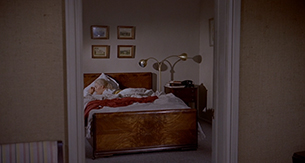 |
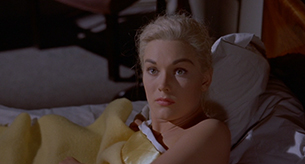 |
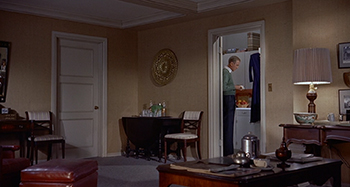 |
 |
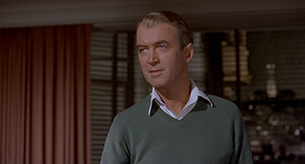 |
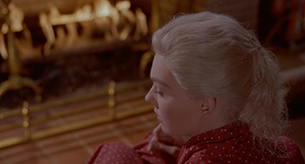 |
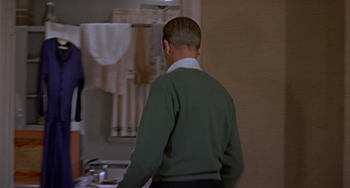 |
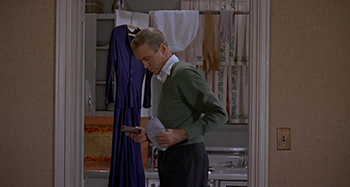 |
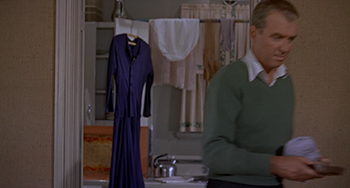 |
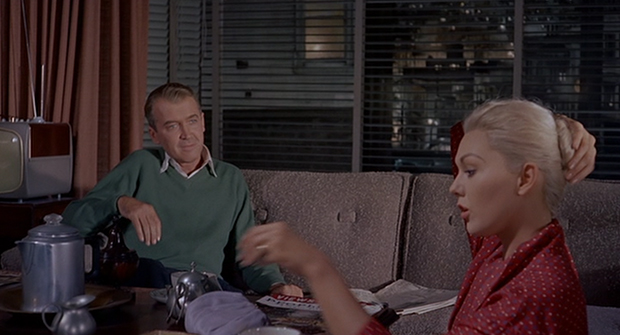 |
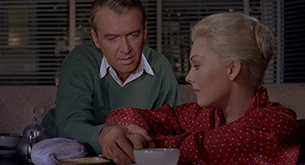 |
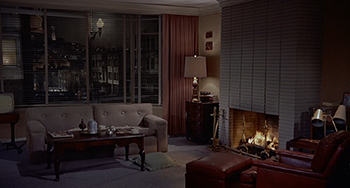 |
 |
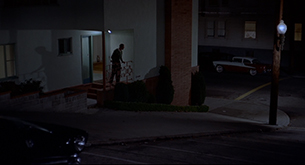 |
Let's backtrack and take a look at John's kitchen. We first see it at the scene's beginning with a pan from John in the living room, to the left, stopping on the kitchen where we see Madeleine's things hanging from a makeshift clothesline. The kitchen appears to be gray, but behind the dress, under the dish cabinet the wall is orange and is likely Formica as the countertop below it may also be orange Formica. On the counter rests the box that holds the pins for Madeleine's hair but right now it's unclear what the object is.
The second time we see the kitchen it is after John has spoken with Madeleine in the bedroom. Anticipating her coming into the living room, he goes to the kitchen to get her a coffee cup. From this view we see a basket of fruit on the counter top and behind it perhaps a tray leaning against the Formica wall.
Our third view of the kitchen is when Madeleine asks for the pins for her hair. When John goes into the kitchen, rather than the box being on the counter, we now see the colorful orange-red tray has been moved to be seen behind her dress—if it is a tray, we see it has print on it and may wonder what it reads. John picks up Madeleine's purse and the pin box from off the stovetop, which is when we understand that what was originally sitting on the counter was that same box. If we haven't noticed the change, Jimmy Stewart pauses and looks, as if puzzled, at the box, which gives us a moment to reflect on it as well.
The final time we see the kitchen is when Madeleine has left. Her clothes gone, she has left John's robe on the counter top. The colorful tray is no longer there. Instead, we see three silver metal canisters for holding dry goods like flour and sugar, and a silver toaster.
There are other things that move, such as the television changing position in the living room, but I don't care about all that—what I am concerned about is the kitchen as these are obvious, in-your-face changes, and we are even given time to puzzle over them when Jimmy Stewart is sent to get Madeleine's pins and purse. I think I'm going to reserve judgment on the kitchen until looking at the scene, in the second act of the film, where Madeleine undergoes her complete transformation for John at the beauty parlor, for it has the same color scheme. What I would like to point out is that the tray that was moved to be behind Madeleine's dress has the same colors in it that we see in John's robe. When the tray disappears in the kitchen, it's almost not noticed because it has been replaced by the robe, which is a completely different thing but works color-wise as a replacement.
In the book, Madeleine jumps into the Seine after stopping at a cafe where she sits outside and writes a letter. When she is done with it, Roger follows her to the Seine where she tears up the letter and throws it in the water, so Roger loses the opportunity to read it. Having thrown the pieces of the letter into the river, Madeleine follows. Roger leaps in, rescues her and takes her back to the cafe, which was previously closed but is now open. The proprietor of the cafe gives them dry clothes to wear, which completely changes Madeleine's aspect for Roger, plus she plays with the proprietor's child. The change isn't pleasing for him. In a house dress, playing with the child, the mysterious Madeleine becomes an ordinary woman of a lower class and loses any appeal, predicting how he will feel about her when she becomes Renee (Judy).
Hitchcock replaced the book's letter with the bouquet that Madeleine tears up and throws into the bay before jumping in.Hitchcock also preserves Madeleine's mystery and appeal at John's, rather than disrupting it, by Madeleine wearing John's own robe, not another woman's simple house dress, and not breaking character. Her hair is mussed, she is barefoot, but elegance is preserved in her manner, and John's robe may contribute to a sense of having, to some degree, possessed her.
John (answers phone ringing next to his bed in which Madeleine sleeps): Yes? (She wakes up. No, it's all right.
I'll call you back. Yes. (Hangs up. To Madeleine.)
You all right? (Hands her his robe.)
You'll want this.
(John goes to the living room and puts out coffee for her. She exits the bedroom.)
You'd better come over here by the fire where it's warm.
Madeleine: What happened?
John: Well, you fell into San Francisco Bay.
And I tried to dry your hair as best I could.
Your things are in the kitchen. They'll be dry in a few minutes.
Come on over by the fire.
Here, I'll get you some cushions.
There you are.
Would you like to have some coffee?
Well, here, you'd better have some. Or perhaps you'd like a drink?
Madeleine: I fell into the bay and you fished me out?
John: That's right.
Madeleine: Thank you.
John: You don't remember?
Madeleine: No, I...
John: Do you remember where you were?
Madeleine: Yes. Of course I remember that.
But then I must have had a dizzy spell and fainted.
John: Where were you?
Madeleine: At Old Fort Point, out at the Presidio.
Of course I remember. I often go there.
John: Why? Why do you go there?
Madeleine: Because I love it so. It's beautiful there, especially at sunset.
Thank you for the fire.
John: Where were you before?
Madeleine: When?
John: This afternoon, I mean.
Madeleine: Wandering about.
John: I know, but where? Where were you just before?
Madeleine: Downtown, shopping.
John: Here, you'd better have some coffee.
I think it's still warm.
Madeleine: You're terribly direct in your questions.
John: I'm sorry, I didn't mean to be rude.
Madeleine: You're not, you're merely direct.
And what were you doing there, at Old Fort Point?
John: Oh, just wandering about.
Madeleine: You like it, too?
John: Yes.
Madeleine: And where had you been just before?
John: I'd been to the Palace of the Legion of Honor, the art gallery.
Madeleine: Oh, yes, that's a lovely spot, isn't it? I've never been inside, but it looks so lovely driving past.
It's lucky for me, you were wandering about.
Thank you.
I've been a terrible bother to you.
John: No, you haven't.
Madeleine: Oh, when you...there were some pins in my hair.
John: The pins, yes. Right in here. I'll get them for you.
Madeleine: And my purse, please.
John: Here you are.
Madeleine: Thank you.
You shouldn't have brought me here, you know.
John: I didn't know where you lived.
Madeleine: You could have looked in my car. But then you didn't know my car, did you?
John: No, I knew which one it was. It's right outside here now.
But I didn't think you wanted to be taken home that way.
Madeleine: No, you're right.
I'm glad you didn't take me home. I wouldn't have known you.
Thank you. But I don't know you and you don't know me.
My name is Madeleine Elster.
John: My name's John Ferguson.
Madeleine: A good, strong name. Do your friends call you John or Jack?
John: John, mostly.
Old friends call me John. Acquaintances call me Scottie.
Madeleine: I shall call you Mr. Ferguson.
John: Gee whiz, I wouldn't like that.
After what happened this afternoon, I should think you'd call me Scottie.
Maybe even John.
Madeleine: I prefer John. (Finishes pinning up hair.) There, that's done. And what do you do, John?
John: I wander about.
Madeleine: That's a good occupation. And you live here, alone? One shouldn't live alone.
John: Some people prefer it.
Madeleine: No, it's wrong.
I'm married, you know.
John: Will you tell me something? Has this ever happened to you before?
Madeleine: What?
Falling into San Francisco Bay. No, no, it's never happened before.
I've fallen into lakes, out of rowboats, when I was a little girl.
I even fell into the river once trying to leap from one stone to another.
But I've never fallen into San Francisco Bay.
Have you ever before?
John: No, it's the first time for me, too.
Here, I'll get you some more coffee.
John (answers the ringing phone in the bedroom): Hello?
Elster: Scottie, what happened? She's not home yet.
John: No, she's all right. She's still here. I'll bring her home soon.
Elster: What happened?
John: She went into the Bay. Hello? Hello?
Elster: Did she hurt herself?
John: No, she's going to be in fine shape. There's nothing to worry about.
But she doesn't know. Now, do you understand that? She doesn't know what happened.
Elster: Scottie, Madeleine is 26. Carlotta Valdés committed suicide when she was 26.
John (hears the front door close): Just hold on a minute, Gavin. (Checks and sees Madeleine has left.)
Midge (drives up to see Madeleine leaving and John stepping out to see her car has gone): Well now, Johnny-O. Was it a ghost? Was it fun? (She drives off.)
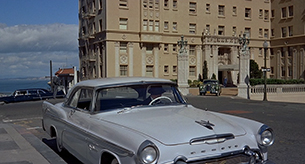 |
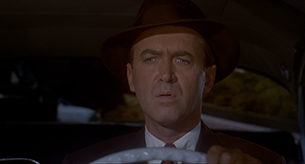 |
 |
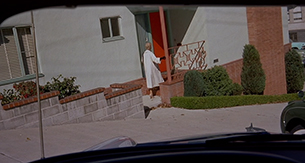 |
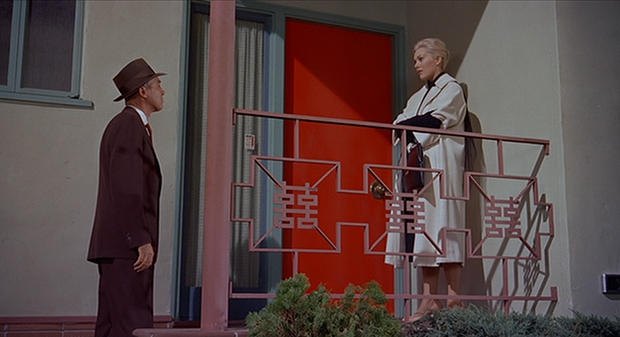 |
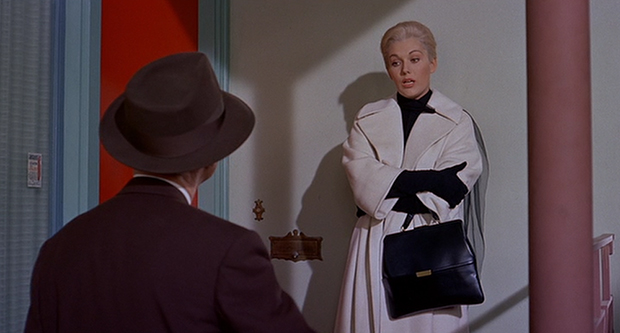 |
 |
 |
In the book, Madeleine had written a letter, torn it up, tossed it into the Seine, then jumped in after it. Hitchcock has instead Madeleine delivering a letter to John after having fled the previous night after he'd rescued her from the bay. This scene opens with John following her from her home, it being the third day, but she breaks routine, puzzling and then surprising him by taking him back to his own apartment where she drops a letter in his mail slot. This means we can have a part of their romance played out in front of John's wonderful bright red door.
In the film, John breaks completely from this being only "business" when he sees Madeleine delivering the letter and gets out of the car to speak with her. No, he doesn't divulge that he has been hired by her husband, but this means she has now been officially introduced to his car and he can no longer use it to follow her. In the book, Roger lets Paul know that he is now keeping company with Madeleine, after her attempted suicide, but in the film John doesn't tell Gavin.
As Madeleine abruptly leaves, Hitchcock has her exit the frame screen right at the bottom, walking out of it, the camera holding on John.It's a great shot because normally the camera should have followed her. She should, at least, have not dropped out of the frame this way. It's Hitchcock reminding how Madeleine easily disappears, the fragility of her presence, and that she is always on the brink of vanishing. This is aided, of course, by John being in the position of having been hired to follow her. He's not going to be the one who leaves the party first. But John can't follow her any longer, she has seen his car, so he makes a bid for their journeying together. But she is no longer only Madeleine, Gavin's wife, who he took the job of following out of friendship with her husband. She is a woman he hopes to make his own. If he can't heal himself, he desires to heal her with rational explanations for her mysterious problems, which will also be a salve for him, but what he most wants are those mysteries that he will attempt to explain away.
The spectacular outfit Madeleine wears today, the white coat with its wide lapels over a black dress, black gloves, will be recalled after John is later released from the hospital and goes to Madeleine's apartment building where he sees what looks like her, a ghost of her, emerging, walking to the green Jaguar. He runs up to the ghost, and it's not her, it's instead an elder woman who had purchased the car from Gavin Elster.
John: That for me?
Madeleine: Yes. Hello.
John: Hello. I worried about you last night. You shouldn't have run off that way.
Madeleine: Well, I suddenly felt such a fool.
John: Well, I wanted to drive you home. Are you all right?
Madeleine: Yes, I'm fine. No aftereffects. As I remember now, the water was cold, wasn't it?
John: Well, it sure was.
Madeleine: What a terrible thing for me to do. You were so kind. It's a formal thank-you note and a great big apology.
John: Well, you've nothing to apologize for.
Madeleine: Oh, yes, I do. The whole thing must have been so embarrassing for you.
John: Not at all. I enjoyed...talking...to you.
Madeleine: Well, I enjoyed talking to you.
John:Well, I'll get my mail. Would you like to have a cup of coffee?
Madeleine: No, thank you. Well, I couldn't mail it. I didn't know your address, but I had a landmark.
I remembered Coit Tower, led me straight to you.
John: Well, that's the first time I've been grateful for Coit Tower.
John (reading): Well, I hope we will too.
Madeleine: What?
John: Meet again sometime.
Madeleine: We have. Good-bye.
John: Where are you going?
Madeleine: Oh, I don't know.
John: Shopping?
-Madeleine: No.
John: Anywhere in particular?
Madeleine: No, I just thought that I'd wander.
John: Well, that's what I was going to do.
Madeleine: Oh, yes, that's right. I forgot. It's your occupation, isn't it?
John: Yea, well don't you think it's a waste for the two of us...
Madeleine: To wander separately? But only one is a wanderer. Two together are always going somewhere.
John: I don't think that's necessarily true.
Madeleine: You left your door open.
John: Be right back.
After the film's credits was the scene in which John and the police officer pursued a man over rooftops, the panorama beyond stretching from the Brocklebank apartments, where Madeleine lives, neighboring the Pacific Union Club, to Coit tower, which is actually quite close to where Midge lives, but is the landmark by which Madeleine states she's been able to find her way back to John's, though he lives on Russian Hill on Lombard Street. The shot from behind the officer, in which we saw the pursued escaping, widened the landscape viewed to include Russian Hill. Between these two locations is the abyss over which John hung, and which haunts him. If we look at this opening panorama as establishing a kind of perimeter, it's thus determined by where Madeleine and John live, the abyss between them. However, it may be important that Coit tower is actually next to where Midge lives, as if this detail is a subtext that should be explored.
Hitchcock is known for having said, as to Coit tower, that it was a phallic symbol. Perhaps so. In it , and based on his remark, we might even find "coitus", but I think his statement deflects from the complexity of the relationship between Madeleine and John.
John, as has been pointed out, doesn't live next to Coit Tower. Instead he lives further up on Lombard Street which is well known in its own right, being often called the crookedest street in the world.
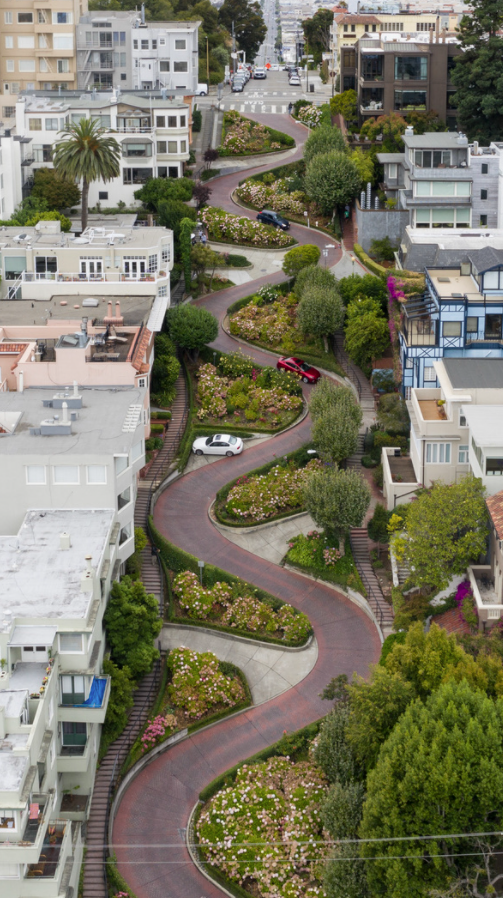
Wikipedia by Christopher Michel
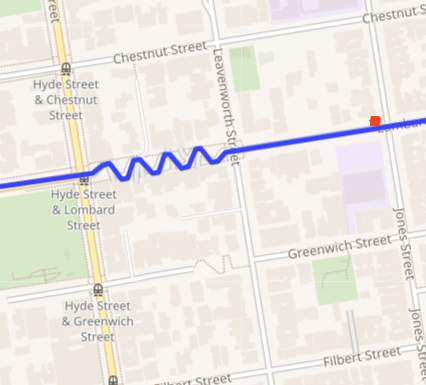
John's apartment on Lombard
Why does John throw up his hands in frustration, following Madeleine this third day, before he finds she has led him back to his home? It may be because she takes him on, when it's plotted out, a rather corrugated route, starting at Mason and California, making left and right turns that create veritable zigzags, necessarily a squared wavelength on city streets, then there's a break in the timeline and we return to find her over to the west, when she was to the east, and she's cutting back east down Filbert Street, then north on Leavenworth, then east on Lombard down to John's apartment. In this way, she and John skirt by the crooked part of Lombard, though we see it behind John as he makes the turn onto Lombard, then we see at the bottom of the block where the white center line of the street makes a sharp angle and stops.
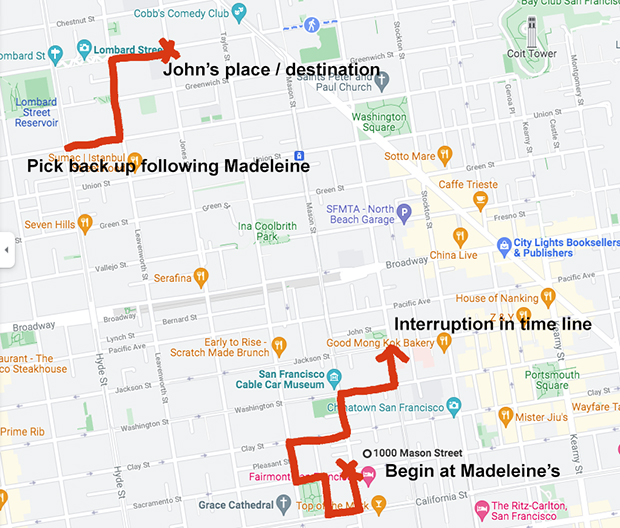
Zigzag Route from Madeleine's to John's
Why am I so interested in Lombard Street and its crookedness and Hitchcock placing John's apartment just beneath the crookedest street in the world but far enough way, at the bottom of the block, that you don't see it? Because of what I've written about on the tabula scalata. the ladder picture, in Part One, observed at Ernie's. How from one perspective you see one image, and from another perspective you see another image. After we see the tabula scalata at Ernie's, Madeleine stops beside John, at the bar, presenting her face in right profile, then turns and shows it in left profile.
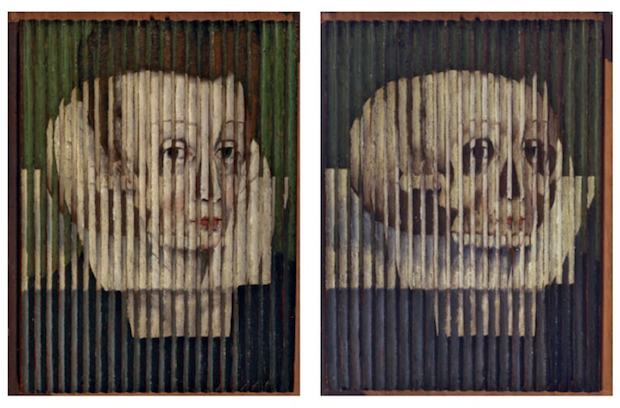
Madeleine has told Scottie that the landmark of Coit's tower led her "straight to him", which I don't think is supposed to be a joke. Instead, I think Hitchcock is drilling in on a theme to make it palpable. The tabula scalata, the crookedest road in the world, the zig-zag route accompanying our learning that John lives at 900 Lombard Street right below the crookedest segment of street in the world--a theme is established by repetition.
The screenplay clearly establishes this zigzag route, as seen below.
EXT. SAN FRANCISCO STREET - (DAY) - LONG SHOT
We see the Jaguar ahead. It turns a left down another street.
It goes for a block and turns right. Then it turns left again,
than it turns right, then it turns left again.
Madeleine driving, though many would believe the pair travel the short distance north of San Francisco to the Muir redwoods, instead the scenery shows them traveling down to the Big Basin redwoods in the Santa Cruz Mountains, which Reelsf.com points out is not far from where was the Hitchcock ranch in Scotts Valley—but, if one knows of the story of Rose Fritz Flood and Constance Stearn Flood Gavin, I would point out John and Madeleine are quite a bit closer to the Bear Creek Redwoods area where was the Rose and James Leary Flood ranch at which Constance Gavin would have spent much of her childhood before the death of the woman she had believed was her mother, after which she was completely abandoned by her father. At Big Basin, they walk out of the light into the dark of the forest, recalling the dusk that so quickly and almost supernaturally took over the Argosy book shop where Leibel related to John the history of Carlotta and how she had killed herself. They stand at the foot of the Father of the Forest Tree and discuss the great age of the trees, Though John seems to look upon them as symbolic of the spiritual hope in everlasting life, "always green, ever living", Madeleine responds with bitterness over the fact she must die.
Has Madeleine been here before? John queries her as though she has related to him the full story of her trances, the possibility that her great-grandmother takes possession of her. He asks when she was born, what takes her away, his desperation for answers such that he obviously knows more than what he could have observed in the brief time he has supposedly known Madeleine, since rescuing her from the bay, and yet Madeleine doesn't wonder at his familiarity, his intensity.
It would seem this is only John's third day following her (we may still think of him as following her, though they are together) and his emotional investment is so profound that his fascination hints at needs that have nothing to do with Madeleine.
 |
 |
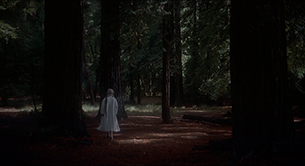 |
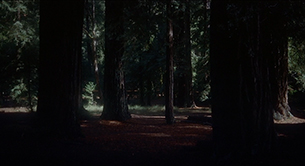 |
Madeleine examines the rings of a tree that has been cut down. For the audience, the rings may remind of the loops of the graphics that opened the film, which had appeared in the pupil of a woman's eye after she had expressed, with the widening of her eyes, a combination of shock, surprise, fear. The vertigo in response to the abyss of infinity that births mortality and consciousness that grasps both. At John's, in her white coat Madeleine had stood against the exterior white wall of his building as she made her apology and told him how she'd found him by way of the Coit Tower that stands high on Telegraph Hill. Now here they are in a forest of natural giants, where light doesn't reach, and within the dark Madeleine stretches out her black-gloved hand to point out where she was born in relationship to the life of the tree. She speaks of her life as so short and vain as to be unnoticed by the Father tree, which she calls "you". "It was only a moment for you. You took no notice." Her god is one that has no knowledge of her.
That black glove that becomes negative space against the dusk of the forest of these giants is a response to and oppositionally complements Madeleine standing against that white wall, the Coit tower in the distance.
Madeleine's disappearing act at the McKittrick Hotel primes John to become anxious when she walks out of sight behind one of the trees and doesn't emerge again from behind it. The camera lingers on the vacuum of her absence long enough that the audience wonders if she may have vanished altogether, but we also know she is still there, for she is not a ghost. John pursues and there she is, as we knew she would be, simply hidden from view by the trees. She entreats him to take her back to the light.
Madeleine: How old?
John: Oh, some 2,000 years or more.
Madeleine: The oldest living things.
John: Yes. You've never been here before?
Madeleine: No.
John: What are you thinking?
Madeleine: Of all the people who've been born and have died while the trees went on living.
John: Their true name is Sequoia sempervirens. "Always green, ever living."
Madeleine: I don't like them.
John: Why?
Madeleine: Knowing I have to die.
John: Here's a cross section of one of the old trees that's been cut down.
Madeleine (touching the cross section): Somewhere in here I was born, and there I died. It was only a moment for you. You took no notice.
John: Madeleine. (She wanders behind another tree, disappearing. John follows and finds her.) Madeleine, Madeleine, where are you now?
Madeleine: Here with you.
John: Where?
Madeleine: The tall trees...
John: Have you been here before?
Madeleine: Yes.
John: When? When were you born?
Madeleine: Long ago.
John: Where? When? Tell me. Madeleine, tell me.
Madeleine: No!
John: Madeleine, tell me what it is. Where do you go? What takes you away?
Madeleine: I can't tell you.
John: When you jumped into the Bay, you didn't know where you were. You guessed but you didn't know.
Madeleine: I didn't jump. I fell. You told me I fell.
John: Why did you jump?
Madeleine: I can't tell you.
John: Why did you jump? What's there inside that told you to jump?
Madeleine: Please.
John: What? What?
Madeleine: Please, don't ask me. Please, don't ask me! Take me away from here.
John: Shall I take you home?
Madeleine: Somewhere in the light. Promise me something.
Promise you won't ask me again. Please promise me that.
Madeleine and John go to the coast, Cypress Point, where John professes to feel responsible for her life as he saved her from the bay. When she breaks away from him to run down the hill, he chases her, not knowing if she might attempt to commit suicide again—and we see in those frames the menacing figure of the man in the hat, on the verge of catching a woman, that is used in one of the film's advertising posters.
John is completely taken with a person who doesn't really exist. She may as well be the ghost that vanished at the McKittrick. She's not there.
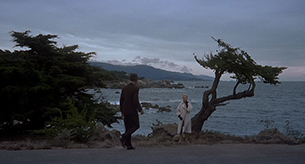 |
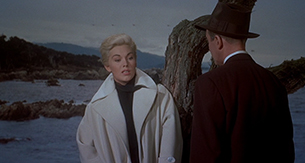 |
The poster was one designed by Saul Bass, who did the opening credits. If we didn't know the story, the impression we're given is of a dangerous, nightmarish dark figure that has caught up with a fleeing woman and grabbed hold of her. Instead, John was chasing Madeleine as she ran because he didn't know if she might again try to plunge into the water, and that chase was immediately followed by a kiss and Madeleine begging John to not leave her.
The screenplay shows that another option for the filming location, rather than Cypress point, was Lobos point.
EXT. CYPRESS POINT OR POINT LOBOS - (DAY) SAME DAY.
Lobos Point might have continued the "wolf" association established in the book, Madeleine as the seducer, but the conversation here focuses on Madeleine's seeing her grave waiting for her, and Cypress Point thus associates with her being buried at Cypress Lawn.
Madeleine: (at the seashore): Why did you run?
John: I'm responsible for you now.
You know, the Chinese say that once you've saved a person's life you're responsible for it forever, so I'm committed. I have to know.
Madeleine: There's so little that I know.
It's as though I were walking down a long corridor that once was mirrored, and fragments of that mirror still hang there, and when I come to the end of the corridor there's nothing but darkness. And I know that when I walk into the darkness that I'll die. I've never come to the end. I've always come back before then.
Except once.
John: Yesterday? And you didn't know what happened till you found yourself with me.
You didn't know where you were. But the small scenes, the fragments of the mirror, you remember those.
Madeleine: Vaguely.
John: What do you remember?
Madeleine: There's a room and I sit there alone. Always alone.
John: What else?
Madeleine: A grave.
John: Where?
Madeleine: I don't know. It's an open grave and I stand by the gravestone looking down into it. It's my grave.
John: But how do you know?
Madeleine: I know.
John: But is there a name on the gravestone?
Madeleine: No. No, it's new and clean and waiting.
John: What else?
Madeleine: This part is a dream, I think.There's a tower and a bell. A garden below. It seems to be in Spain, a village in Spain.
It clicks off and it's gone.
John: Well, a portrait? Do you see a portrait?
Madeleine: No.
John: If I could just find the key, the beginning, and put it together, I...
Madeleine: And explain it away? There is a way to explain it, you see. If I'm mad, well that would explain it, wouldn't it? (She runs.)
John (catches her): Madeleine!
Madeleine: Oh, Scottie!
I'm not mad! I'm not mad! I don't want to die.
There's someone within me, and she says I must die.
Oh, Scottie, don't let me go.
John: I'm here. I've got you.
Madeleine: I'm so afraid. (They kiss.) Don't leave me. Stay with me.
John: All the time.
Midge is painting. She hears a door, footsteps coming up stairs. Now, finally, on John's third visit to Midge's apartment, Hitchcock shows that John doesn't even need to knock before entering. We had already suspected, with his second visit, that he has a key as Midge doesn't have to go to the door to let him in. With this third visit, when she hears the footsteps, she knows they belong to John and she hurries to hide something, which we will find is a copy of Carlotta's portrait from which she is working, tucking it under the cushion of the bentwood lounge chair. This is how intimate they are, that John enters her apartment without knocking, but their conversation reveals that Midge doesn't have a key to John's apartment as she had to slip a note to him under his door. What's fascinating to me is that such care was taken with this revelation, over three different visits, that Hitchcock and the writer were going to drag this out rather than having these details established on the first or second visit, and how many in the audience will ever even consider whether or not John has his own key and is free to enter when he pleases?
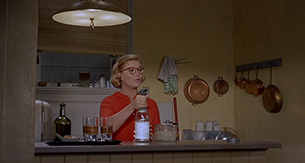 |
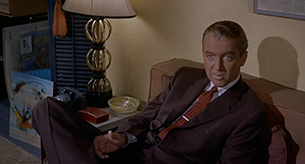 |
As John enters we see, on the screen between the main room and the door, the shadow of a small, model Greco-Roman temple or altar that's set on a dresser. It might have been noticed when John entered her apartment before they went to the bookshop, but it's doubtful, though it was always there, for what draws attention now is the shadow it casts. The model has already struck me as having likely great significance, but even more so if we consider it in context of the Portals of the Past which Gavin said Madeleine would sit and contemplate. With the screen and the shadow of the temple on it, one could read into it a kind of temple veil leading to the sanctuary, and that sanctuary, surprisingly, is in Midge's apartment. Midge, who rejected him and yet pines for him, serves as a kind of sanctuary until she does the painting of herself as Carlotta, which is an odd scene, because Midge, unlike Judy, is a woman who would likely resist being changed to suit another, and yet she injects herself into the painting. The last we see of her, she is at the hospital, asking John's doctor how long John will he be catatonic, knowledgable that a music cure won't fix him. She identifies her role as "mother" and disappears from the story when Judy enters. Well, she disappears unless we consider the final scene and that it is a nun, a "mother", who comes upon John and Judy in the bell tower, in shadow form, the surprise of her causing Judy to fall to her death. And John is restored to "health" (of a sort), his balance regained, his obsession likely purged.
One can already feel the gulf that is entering between Midge and John as he rests on the sofa. He is guarded, suspicious of her desire to talk to him. His playful manner is gone. Without saying as much, he communicates he's not going to speak about Madeleine which means shutting the door on what now encompasses his entire focus, his life. She knows he doesn't want to talk about Madeleine, that he has become wholly involved with her, but she attempts to negotiate a path to that conversation anyway.
How Midge does this is a mystery. Befuddling. John asks what she's been doing. She says she's returned to her first love and is painting a picture that she is considering giving to him. The audience is as taken aback as John to see that Midge has painted herself as Carlotta.
John's expression, seeing the image, is one of revulsion. When his gaze turns to Midge, it is one of near hate.
And then maybe a sense of shame and despondency as well follow, communicated in the manner in which he leaves her apartment.
What is going on? Why would Midge paint this portrait? John and Midge joke a good deal, but did she really think this could break the ice that separated off the subject of Madeleine and made it taboo? Did she misjudge the level of John's involvement with Madeleine, thinking it was not yet so intense and that John could still get a joke and check his equilibrium?
Where did the idea of Midge, the commercial artist and painter spring from, anyway? Movie commentary on my DVD states that it was the idea of the scriptwriter, that John was going to need a sounding board to keep him and the film grounded in reality. But I also read that Hitchcock already had the film plotted and the scriptwriter fleshed out the dialogue. In the book, Roger (John) had no sounding board, the only other persons with whom he converses in the first part are Paul (Gavin) and Madeleine, and in the second part he only converses with Renee (Judy). He's a solitary individual and his world is easily manipulated and reformed by them. So it's perhaps notable that parts of MIdge actually come from Madeleine and her great-grandmother, for her great-grandmother was a painter and had painted her own portrat. When Paul met Madeleine she was studying painting, but had given it up and turned her studio into a sitting room. Roger appreciates that Madeleine might be creative and imagines that the real problem might be she is simply bored with Paul and a life of easy luxury, yet when he sees her removed from it he rebels, his attraction dies, he becomes disgusted and loses interest. Now here is Midge, the commercial artist who is returning, she says, to her first love, painting, which reminds also that she and John had once been engaged, which is difficult to comprehend at this stage of their relationship. There is no physical intimacy of any sort between them to suggest that they were ever lovers or even simply, physically affectionate.
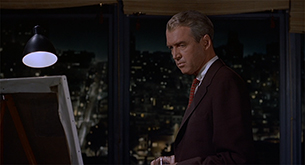 |
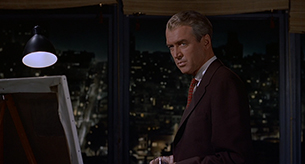 |
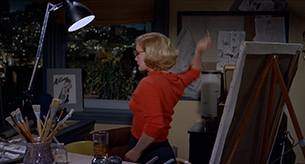 |
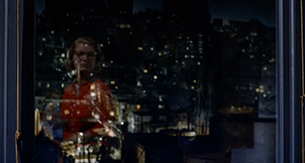 |
Midge may understand too well what John's problem is. She may have experienced it when she and John were engaged, which is why she broke it off. She loves John, but a healthy part of self-preservation must have removed her from the situation.
When John walks out, she violently reacts to her miscalculated attempt to wake Johnny out of his fascination with Carlotta-Madeleine. She destroys the painting and throws her paintbrush at the window. One should puzzle over the shot we have of Midge looking at her reflection in the window's dark, against San Francisco, for we can consider it complementing and remarking upon the painting we've just observed of Midge as Carlotta. Anguished, she pulls her hair away from her face, up on her neck, which is not like Madeleine's but it can be imagined how this action is intended to point to Madeleine.
By the way, since I've spoken about how John can just enter Midge's apartment at will, while she can't do the same with his apartment, and since we know that John lives at 900 Lombard Street...do you know whose apartment Midge can view from her apartment?
John's apartment, right up there in the vicinity of that red dot, 900 Lombard Street. Maybe a little below it. Perhaps Midge can look out the window and see when John is on his way over? The point being that they live within view of one another. Just occurred to me to check that out with Midge looking out the window.
Actually, I begin to wonder what subtle controls John does exert over Midge that keeps their relationship balanced to his satisfaction, just the way he likes it, and keeps her not looking for anyone else. Obviously, Midge still has some intense feelings for him.
Midge: Hi, Johnny.
John: Hi.
Midge: Did you get my message?
John: I did indeed.
Midge: I'll get you a drink.
John: Okay. Since when do you go around slipping notes under men's doors?
Midge: Since I stopped being able to get them on the phone. For a man who has nothing to do, you're certainly a busy little bee. Where do you go these days?
John: Oh, just wandering.
Midge: Where?
John: Round about.
Midge: Oh.
John: What was this...what was this desperate urge to see me?
Midge: All I said in my note was: "Where are you?"
Doesn't sound very desperate to me.
John: Oh, I detected a little undercurrent.
Midge: I just thought that if I gave you a drink, and fed you some dinner, you'd be so grateful you'd take me to a movie.
John: Well, that's fair enough. What'll we talk about at dinner?
Midge: Oh, this and that.
John: What I've been doing?
Midge: If you want to. I'm sure we won't talk about anything you don't want to talk about.
John: Naturally.
Midge: What have you been doing?
John: Wandering. What have you been doing? Thank you, dear.
Midge: Oh, I've been having a wonderful time. I'm going back to my first love: painting.
John: Good for you. I always said you were wasting your time in the underwear department.
Midge: Well, it's a living. But I'm really excited about this.
John: What is it? A still life?
Midge: No, no, not exactly. You want to see? In fact, I thought I might give it to you. Johnny...
John: Oh? It's not funny, Midge.
Midge: Johnny?
John: No.
Midge: Johnny, I just thought...
John: No, let's make that movie some other night.
Midge: Johnny? Oh, Marjorie Wood, you fool! Idiot! Stupid! Stupid!
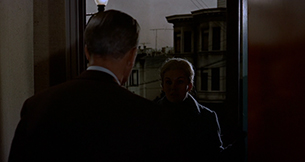 |
 |
John, troubled, spends the night walking, then falls asleep on his sofa. He's woken by Madeleine at his door, in silhouette, her face in deep shadow. She's frantic for she has had the dream again of the Spanish town and has left her bed, her home, Gavin, to flee to John and tell him about it. John identifies the place she describes, San Juan Bautista (St. John the Baptist) which has been preserved as a historic site. But Madeleine protests she's never been there. He sends her back to Gavin, both having agreed they will travel to San Juan Bautista that day at about noon.
An oddity in the scene is a book that John has on his desk, "Coloring Photographs." As far as we know he isn't a photographer (he never touches a camera), he is no artist, yet there is this well-used book. I tried looking it up and was unable to find a book of this title. Cyril Coulon saw I was unable to find it and wrote to say it's the 1945 version of Coloring photographs in oil and water colors by Avenir Le Heart, which was originally published in 1934.
The timing of the book's appearance is peculiar, after we have seen Midge's painting of herself of Carlotta, for she would have been working from a black-and-white photograph of the painting of Carlotta.
Could this possibly belong to Midge?
In the novel, Roger dreams in black-and-white, while Madeleine says she dreams in color.
"Ah!" he exclaimed. "You're in black today."
"I love black. If I had my own way, I'd wear nothing else."
"Why? It's a bit mournful, isn't it?"
"Not at all. On the contrary, it gives value to everything, it makes all one's thoughts more important and obliges one to take oneself seriously."
"And if you were in blue, or green?"
"I don't know. I might think myself a river or a a polar...When I was little, I thought colours had mystical properties. Perhaps that's what made me want to paint."
She took his arm, with an abandon that almost submerged him in a wave of tenderness.
"I've tried my hand at painting, too," he said. "The trouble is, my drawing's always so weak."
"What does that matter? It's the context that matters."
"I'd love to see your paintings."
"They're not worth much. You couldn't make head or tail of them, they're dreams really...Do you dream in colour?"
"No. Everything's gray. Like a photograph."
"Then you couldn't understand. You're one of the blind."
She laughed and squeezed his arm to show him she was only teasing.
"Dreams are so much more beautiful than the stuff they call reality," she went on. "Imagine a profusion of interweaving colours which penetrate right into you, filling you so completely that you become like one of those insects which make themselves indistinguishable from the leaf they're resting on...Every night I dream of...of the other country."
"You too?...When I was a boy I was obsessed myself by that unknown world. If we had a map here I could show you the exact spot where it begins."
"That's not the same one."
"Oh, yes, it is. My end of it is dark, yours full of colour, but they join. It's the same world."
Roger's descriptions of Madeleine go back and forth--sometimes she is the one coloring his world, but he has also described her as being like the shades when Aeneas vists Hades and spills blood, how the spirits are drawn to the blood and gain substance from it, becoming animated. Roger believes Madeleine is a little like this and describes her as sapping his strength, though he never calls her a succubus, a vampire.
"You remind me of Aeneas."
"Why?"
"Don't you remember? When he went down to the nether world, he poured blood on the ground all around him. And the shades came out and sniffed at it and the smell of it gave them for a moment a semblance of consistency, and they chattered and chattered..." "But what's that got to do with me?"
He pushed over to her the plateful of croissants.
"Gon on—eat them up, all of them. I can't help feeling that you too lack substance. So go on eating, little Eurydice!"
That Madeleine should seem insubstantial considering she is a double, a fiction who only lives around Roger, is appropriate. But as Madeleine's dream world is given as vibrant, whereas his is in black-and-white, Roger too is like a vampire, enlivened by Madeleine as well as drained by her.
The novel holds that Madeleine's dressing in black supplies value to everything else, which was well communicated the first morning John followed her, into a back alley, through the dark rear entry, to look through a crack in the door and see Madeleine surrounded by an explosion of color at the flower shop.
John: Madeleine! What's the matter?
Madeleine: I should have phoned, but I wanted to see you, be with you.
John: Why? What's happened?
Madeleine: I had the dream. The dream came back again.
John: It's gonna be all right. It'll be all right. Here, I'll get you some brandy. Drink this down.
Just like medicine. There now. It was a dream. You're awake. You're all right now. Now, can you tell me?
Madeleine: It was the tower again, and the bell and the old Spanish village.
John: Yes?
Madeleine: Clear, so very clear for the first time. All of it.
John: Tell me.
Madeleine: It was a village square and a green with trees and an old whitewashed Spanish church with a cloister. Across the green, there was a big, gray wooden house with a porch and shutters and a balcony above a small garden. and next to it a livery stable with old carriages lined up inside.
John: Go on.
Madeleine: At the end of the green, there was a whitewashed stone house with a lovely pepper tree at the corner.
John: And an old wooden hotel from the old California days? And a saloon? Dark, low ceilings, with hanging oil lamps?
Madeleine: Yes.
John: It's all there. It's no dream. You've been there before. You've seen it.
Madeleine: No, never.
John: A hundred miles south of San Francisco, there's an old Spanish mission, San Juan Bautista it's called, and it's been preserved exactly as it was 100 years ago as a museum. Think hard, darling. Think hard. You've been there before. You've seen it.
Madeleine: No, I've never, I've never been there. Oh, Scottie, what is it, I've never been there.
John: Think hard. Now, go on about your dream. What was it that frightened you so?
Madeleine: I stood alone on the green searching for something, and then I started to walk to the church, but then the darkness closed in and I was alone in the dark, being pulled into the darkness. I fought to wake up.
John: You're going to be all right now, Madeleine.
You've given me something to work on now.
I'm going to take you down to that mission this afternoon, and when you see it, you'll remember when you saw it before, and it'll finish your dream. It'll destroy it, I promise you. All right? Go on, now. I'll take you home.
Madeleine: No. I'll be all right.
John: You'll come back here around noon.
In the book, the German offensive has started. War is resolutely on the way and Roger feels a sense of relief and release with it. The trip to San Juan Bautista happens much as in the book. Madeleine describes a place she has dreamed. He says it exists, he knows it, she must have been there previously. She states she has never been there except perhaps in a former life. They drive down. She enters the church, races up the stairs of the bell tower, Roger's vertigo makes him too ill to be able to pursue her, he hears her scream, he doesn't see her plunge but sees the shadow of her fall pass over the wall. He goes down the stairs. He attempts to look at her body, but can only stomach a glimpse of it, seeing blood in her hair, knowing from the death of the officer who fell off the roof what happens and not wanting to see the trauma inflicted on Madeleine. He leaves.
In the film, as John drives Madeleine down to San Juan Bautista, we are given Madeleine's point of view gazing on the road ahead, her point of view as she looks up at the sky. These seem trivial shots, but we notice they have been stoked with meaning. Shots that are asking us to notice them.
The story the first time through is that Madeleine, possessed, dives to her death because for some reason she must, compelled by her past, Carlotta's past, the urge to repeat it. It has become her destiny and she must fulfill it. But even the first pass through the film this doesn't sit right, Madeleine's plea that it's too late, that there's something she must do, that it wasn't supposed to be like this.
The livery stable scene, there's something a little cheesy about it, and strange, too, an ill-fit, that Madeleine's here to commit suicide but she sits in a 19th century carriage like they are tourists who have paid the entry fee for an afternoon's entertainment at a historic site. The gray mannequin horse feels grotesque. With that mannequin, the livery becomes a stage and a gift shop is expected to be around the corner. John's attempt to reassure her that the gray horse she remembers is one she'd seen as a child, not in a former life, is feeble. He assures nothing supernatural is actually happening, Madeleine is not possessed. He grabs at practical answers for her nightmarish obsession.
In the book, one of the outstanding things about Roger is the revelation that he has never fallen in love before.
...when Flavières tried to envisage life without Madeleine, he crumbled. His jaw dropped; he had to lean on his desk to prevent himself falling...What did he know about love, he who had never yet loved anybody! Of course he had hankered after it, like a poor wretch gazing into a shop window, he had, so to speak, made passes at it...This strange new pain which gnawed at his entrails, constricted his chest making it difficult to breathe, and prevented him thinking clearly about anything, was the thing they called love. He felt himself ready to commit every extravagance and stupidity, and was almost proud of it in spite of his misery.
That may just be John's problem. He has desired or liked but has never been in love. He had never before met an incredible, mysterious, unearthly fantasy of a very wealthy woman that had been conjured for the purpose of alluring him and hiding the death of another.
When Madeleine runs out of the stable it's at the extreme right of the frame, much like the shot of her leaving John's home the morning before, and he followed her to her car and it was decided they would spend the day together. She crosses the lawn of the square, probably in much the same direction as the nun we earlier observed.
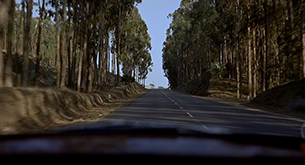 |
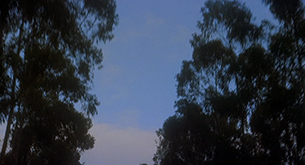 |
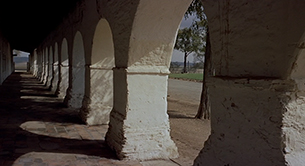 |
 |
 |
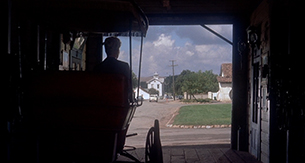 |
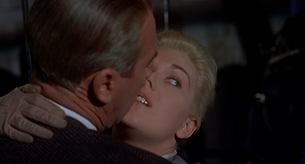 |
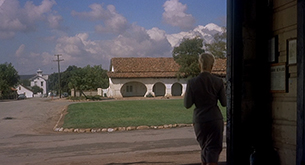 |
He catches her and she folds against his chest before fleeing again. The shot of John embracing Madeleine before the church duplicates when, practicing trying to get over vertigo, he fell from the stepstool into Midge's arms. Why duplicate that posture now? Because of, "Look up, look down," which is what John had recited as he tried exorcizing his vertigo. Madeleine having entreated John to let her go into the church alone, John will see her look up to the bell tower.
I am reminded of the following from the book:
A small group of people were clustered in front of a picture. Flavières had a glimpse of a cross, a white body, the head hanging down over one shoulder, a trickle of blood under the left breast, a woman's face lifted towards the sky.
When John enters the church, chasing after Madeleine, and he pauses, we have the feeling that for a moment he is returned to the Mission Dolores in which he saw Madeleine exit a far door behind the communion rail that separates off the altar area. Because of Mission Dolores, he expects to see her go through that door, but she's not there. He looks right and sees the baptismal fount. He looks left—and there are the stairs to the bell tower.
On the stairs, John attempts to catch up with Madeleine, but he's dizzy and physically ill from his vertigo. Despite knowing she is racing up the stairs to commit suicide, he can't force himself to go faster, his body won't permit him. Madeleine exits through the trap door, he hears a scream, sees her plunge past the window.
In horror, John descends the stairs, but rather than exiting the church to where people are gathering, he exits away from them.
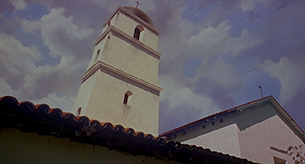 |
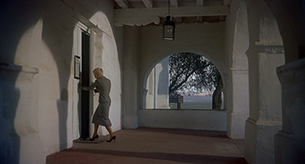 |
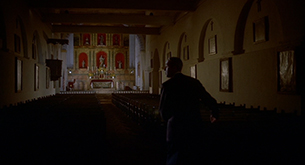 |
 |
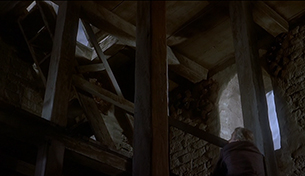 |
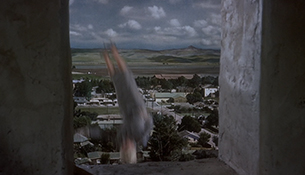 |
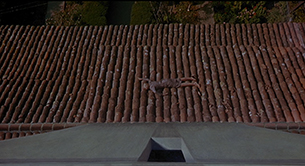 |
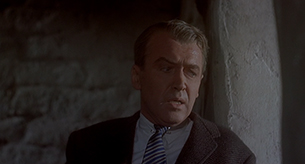 |
Even the first time through, we know that Madeleine hasn't died. If we don't know the plot already from the film's popularity, we know something is wrong and that we'll find out what's wrong in the second act. If we don't know the plot, even if we know something is off and that Madeleine is not dead, it's likely we'll accept the romance, that will be our initial experience, John loves Madeleine and Madeleine loves John and the mystery is what enters between them and keeps them apart to such an angry degree that Madeleine must appear as though she has died.
It was her indifference to life—that was the real secret. She had walked out of it without a qualm. She had plunged head first, her arms wide open, welcoming the earth that was about to kill her. It wasn't so much that she was escaping this life, she was going back to something, going home.
John's Eurydice has fled back to the underworld. In the book, he had even gifted Madeleine with a lighter and cigarette case and the note "A Eurydice ressucitée" to remind her of how he had rescued her from the Seine, from death, to let her know how much he loves her. As he left Madeleine's death scene, he had seen the lighter had spilled out of her pocketbook and took it with him.
John: Madeleine, where are you now?
Madeleine: Here with you.
John: And it's all real! It's not merely as it was 100 years ago, or a year ago or six months ago or whenever it was you were here to see it. Now, Madeleine, think of when you were here.
Madeleine: There were not so many carriages then.
There were horses in the stalls, a bay, two black and a gray. It was our favorite place, but we were forbidden to play here. Sister Teresa would scold us.
John: Look at this. Here's your gray horse. Have a little trouble getting in and out of the stall without being pushed but even so...You see? There's an answer for everything. (She doesn't respond.) Madeleine, try.
Try for me. (They kiss.) I love you, Madeleine.
Madeleine: I love you, too. Too late. Too late.
John: No, no. We're together.
Madeleine: No, it's too late. There's something I must do.
John: No. There's nothing you must do. There's nothing you must do.
No one possesses you. You're safe with me.
Madeleine: No. It's too late. (She runs and he catches her.)
Look, it's not fair. It's too late. It wasn't supposed to happen this way. It shouldn't have happened.
John: But it had to happen. We're in love. That's all that counts.
Madeleine: Oh, let me go! Please let me go!
John: Listen to me. Listen.
Madeleine: You believe I love you?
John: Yes.
Madeleine: And if you lose me, then you'll know I loved you and I wanted to go on loving you.
John: I won't lose you.
Madeleine: Let me go into the church, alone.
John: But why? (He sees her look at the tower as she walks away.)
Madeleine!
Continue to Part 4
December 2021. Approx 10,600 words or 21 single-spaced pages of text.
Return to the top of the page.